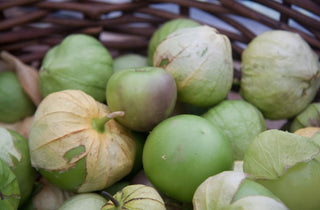Tomatillos are an essential ingredient for salsa verde and many other Mexican dishes. They are easy to grow, but are rarely planted outside the Southwest. These members of the tomato family produce 1-2" diameter fruits that can be green, purple or yellow. Tomatillos are also called husk tomatoes; the fruits develop inside a dry papery husk. When they are ripe the husk bursts open to reveal the ripe fruit inside.
Tomatillos need to be started indoors six to eight weeks before the last spring frost. They can be transplanted into the garden after the soil warms up and any danger of frost has passed. To ensure cross-pollination and fruiting, it's important to grow at least two plants. Fruit usually begin to ripen 60 to 80 days after the plants are put out into the garden. The plants will continue producing right up to frost.
Full sun and good drainage are required for growing tomatillos, but they do fine in average garden soil. There's no need to give them fertilizer; too much nitrogen will result in lots of foliage and very little fruit.

Like tomatoes, tomatillos need some support or they will sprawl over the ground and intrude on neighboring plants. Large tomato cages work well for tomatillos. Like tomatoes, you can set the transplants a little deeper in the ground than they were in their pots. The buried stem will turn into extra roots and help feed the plant.
A full-size tomatillo will need more than a 12x12" space. The solution is to plant lettuce, spinach or radishes in the spaces around the tomatillo. Once those early crops have been harvested, you can let the tomatillo take over a little more space. Prune the plant if it gets too rangy.
Plant tomatillos on the north end of your raised bed. This is a good place to put tall plants; they won't shade other plants as much as they would if they were planted on the south side.
Picking your tomatillos as they ripen will encourage the plant to keep producing. Try to harvest all the fruits even those that drop to the ground. Fruit that's left on the ground will drop seeds and those seeds have a tendency to start popping up everywhere the following spring.
Tomatillos can be chopped and added raw to salsas and guacamole. They can also be saut饤 or roasted. If storing fresh ones in the refrigerator, leave the husks on until you are ready to use them.
Cape gooseberries or ground cherries have a similar appearance and growth habit. The fruit is smaller and sweeter, and has a fruitier, pineapple-like flavor.





